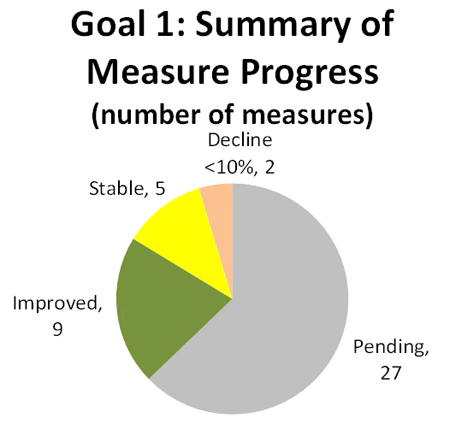Fiscal Year 2015 was a milestone year for HHS, highlighted by the 50th anniversary of the Medicare and Medicaid programs, and the 5th year since the passage of the Affordable Care Act (ACA). Medicare and Medicaid were signed into law by President Johnson in 1965, providing a foundation for health and financial security for our elderly and most vulnerable citizens. Today, 1 in every 3 Americans is covered by one of these programs. Medicaid and the Children’s Health Insurance Program (CHIP) cares for over 71 million Americans, and one-third of our children; Medicare covers virtually every senior in America; and together these programs provide care for nearly 10 million disabled Americans.
Health Care Payment Reform
In January of 2015, the Secretary announced a goal to increase the percentage of Medicare fee-for-service payments that flow through alternative payment models that hold providers accountable for quality and value to 50% by the end of 2018. As part of our new agency priority goal to “Shift Medicare health care payments from volume to value” we will work to increase the percentage of Medicare Fee-for-Service (FFS) payments tied to quality and value through alternative payment models (APMs) to 30 percent by the end of CY 2016 and 40 percent by the end of CY 2017. These efforts include testing alternative payment models such as Accountable Care Organizations and Bundled Payments.
On March 23, 2010, President Obama signed the ACA into law, transforming and modernizing the American health care system. The ACA put in place comprehensive health insurance reforms and access to affordable health insurance options to millions of Americans. Over 17.6 million people have gained health insurance coverage. As of the end of 2015, 30 states and the District of Columbia had expanded Medicaid coverage to low-income adults. Since 2010, the uninsured rate in this country has fallen by nearly 45 percent, the largest reduction in decades.
Goal One includes six objectives:
- Make coverage more secure for those who have insurance, and extend affordable coverage to the uninsured
- Improve health care quality and patient safety
- Emphasize primary and preventive care, linked with community prevention services
- Reduce the growth of healthcare costs while promoting high-value, effective care
- Ensure access to quality, culturally competent care, including long-term services and supports, for vulnerable populations
- Improve health care and population health through meaningful use of health information technology
HHS’s efforts in patient safety as well as health care quality are reflected in the Improve Patient Safety Priority Goal, in order to reduce Healthcare-Associated Infections (HAIs). These infections can lead to significant morbidity and mortality, with tens of thousands of lives lost each year. Leveraging the combined programmatic efforts within HHS, including the Agency for Healthcare Research and Quality (AHRQ), the Centers for Disease Control and Prevention (CDC), the Office of the Assistant Secretary for Health (OASH) and CMS, the Improve Patient Safety Priority Goal is working to reduce catheter-associated urinary tract infections (CAUTI) by 10 percent in hospitals nationwide by the end of FY 2015. The midway target for the FY 2014-2015 national CAUTI standardized infection ration (SIR) reduction in hospitals was 5 percent or a SIR of 0.97. The national FY 2014 CAUTI SIR data (March 2015) reflects a SIR of 0.98, a 4.9 percent reduction, just shy of the target. The final data will be reported in March of 2016.
At the heart of HHS’ strategy to strengthen and modernize health care is the use of data to improve health care quality, reduce unnecessary health care costs, decrease paperwork, expand access to affordable care, improve population health, and support reformed payment structures. A key step in this strategy is to increase the number of eligible providers serving Medicare and Medicaid beneficiaries who adopt and meaningfully use certified EHR technology. The improvement of health care through meaningful use of health information technology was a Priority Goal for the FY 2014-2015 period, with a goal of increasing the number of participating providers receiving incentive payments to 450,000 by the end of 2015. As of the end of FY 2015, over 478,000 providers have received incentive payments, surpassing the target.
For 50 years, health centers have provided a source of high-quality care for people in rural and urban communities throughout the U.S. and its territories. During the 2015 golden anniversary year, the Health Centers Program connected even more people to the care they need by funding 430 new health center sites, using resources made available by the Affordable Care Act. These new sites will provide individuals and families access to affordable, quality health care, including the preventive and primary care services that will help keep them healthy. What started with one clinic in rural Mississippi and another in South Boston is today a national program that supports 1,300 community-based and patient-directed health centers with 9,000 sites serving nearly 23 million persons, or about one in fourteen people living in the United States. These new sites are projected to increase access to health care services for over 1.8 million patients.
For this goal, 88 percent of measures with available data showed stable or improved performance.


